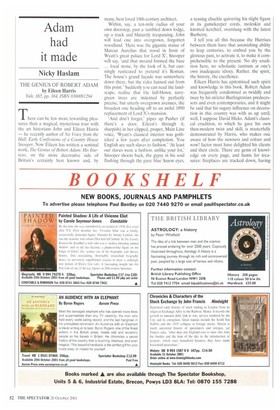Adam had it made
Nicky Haslam
THE GENIUS OF ROBERT ADAM by Eileen Harris Yale, £65, pp. 384, ISBN 0300081294
There can be few more rewarding pleasures than a magical, mysterious tour with the art historians John and Eileen Harris — he recently author of No Voice from the Hall: Early Confessions of a Country House Snooper. Now Eileen has written a seminal work, The Genius of Robert Adam: His Interiors, on the more decorative side of Britain's certainly best known and, by
many, best loved 18th-century architect.
Within, say, a ten-mile radius of your own doorstep, past a tumbled down lodge, up a track and blatantly trespassing, John will lead one into overgrown, forgotten woodland. 'Here was the gigantic statue of Marcus Aurelius that stood in front of Wyatt's great palace for Lord X', Snooper will say, 'and that mound formed the base ... local stone, by the look of it, but cunningly rusticated to pretend it's Roman. The house's grand facade was somewhere down there, but the rides fanned out from this point.' Suddenly you can read the landscape, realise that the full-blown, navygreen trees are indented by perfectly precise, but utterly overgrown avenues, the broadest one heading off to an awful 1890 replacement of Lord X's mansion.
'And don't forget,' pipes up Pusher (if there's a door, Eileen's through it, sharpish) in her clipped, proper, Main Line voice, `Wyatt's classical interior was gothicked a few years after completion. You English are such slaves to fashion.' 'At least our slaves were a fashion, unlike your lot,' Snooper shoots back, the gypsy in his soul flashing through the pure blue Saxon eyes,
a teasing chuckle quivering his slight figure in its gamekeeper cords, moleskin and knotted kerchief, overslung with the latest Burberry.
I tell you all this because the Harrises between them have that astonishing ability to leap centuries, to enthral you by the glorious past, to activate it, to make it comprehensible to the present. No dry erudition here, no scholastic tantrum at one's own inadequate idiocy. Rather, the spirit, the history, the excellence, Eileen Harris has epitomised such spirit and knowledge in this book. Robert Adam was frequently condemned as twiddly and twee by his stricter Burlingtonian predecessors and even contemporaries, and it might be said that his sugary influence on decoration in this country was with us up until. well, I suppose David Hicks. Adam's classical erudition, to which he gave his own then-modern twist and skill, is masterfully demonstrated by Harris, who makes one aware of how the newness and colour and wowl factor must have delighted his clients and their circle. There are gems of knowledge on every page, and hunts for treasures: fireplaces are tracked down, having
been bundled off to servants' rooms in faraway seats as fashion changed; brilliant colour and pattern is discovered under the petit four redecorations; which building in Rome influenced which wing for which grandee ...
Besides a bumper crop of vibrant photographs of Adam's surviving rooms there are wonderfully mournful black and white archival ones of his lost, abandoned, destroyed or drastically altered buildings. For a man so deceptively simple as an exterior architect, so wildly inventive, vivacious and perfectionist in the detail of his interiors, Robert Adam has, in Eileen Harris, the ideal and supreme chronicler.



























































































 Previous page
Previous page